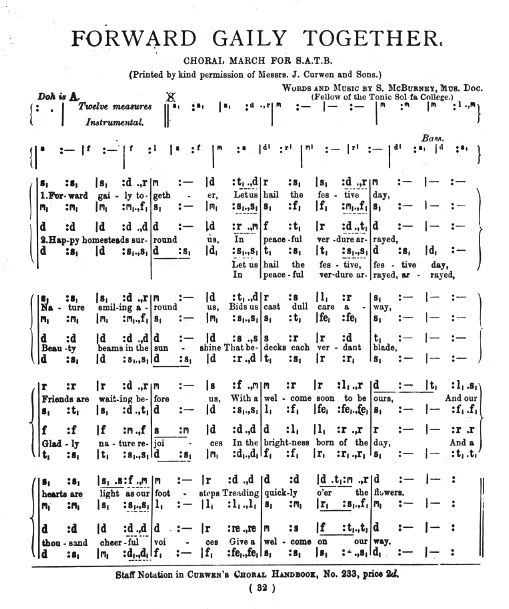《字母谱》最早由英国人柯温加工整理而成。
由于欧洲拼音文字的特点,决定了《字母谱》必定起源于欧洲,西方人说,用字母作唱名的“首调唱名法”最早它是由英国诺威齐(Norwich)地方的女教师莎拉·格罗威尔女士(Sarah AGlover1786-1867)根据先前兰开夏体系发明的(Lancashire system),当时称做《Tonic Sol-fa》这种讲法颇具争议,因为,我们中国流传千年的古代《工尺谱》就是用“首调唱名法”的。
欧洲人用字母作为唱名的《字母谱》又称《Tonic Sol-fa》,这种视唱法在1840年最后由约翰·柯温(JohnCurwen1816-80)加工整理而成。经 J 柯温 改进完善,简单实用,其中,si 改成 ti 也称 (兰开夏唱名法lancasbire sol-fa),在1840年(中国道光二十年)获得英国当地行政部门的支持。《索法谱》在讲英语的各地区曾被广泛使用。兰开夏郡是英国滨海之郡,与爱尔兰隔海相望,当地居民能歌善舞。常年盛产红玫瑰。气候宜人,物产丰富。
我国现代的唱名法,自然音级的唱名为 :多、来、米、法、手、拉、西,是在清末民初由西方引进。
我国古代《工尺谱》唱名,受到了汉字字符发声局限性,必然遭到了淘汰的命运,因为欧洲的拼音文字,唱名发声的选择范围比起我国方块字的指定发音有更多选择。优选的可能性就大大增加,“多、来、米、法、手、拉、西”七个唱名,发音的舌位高,发声响亮,韵音强势,a、o、i、是几个最常用的优秀尾音。从而轻松地打败了我们的“上、尺,工、凡、六‘五’乙”老唱名,“多、来、米、法、手、拉、西、不出几年就传遍全国与东南亚,现在,这唱名就同阿拉伯数字、拉丁字母、公元纪年一样,已成为了人类的共享文化。
再说“首调唱名法”,西方人一直认为是他们在1830年间由格洛佛发明的,到了中国他们才知道,原来“首调唱名法”就是中国流传千年的传统唱名法,例如:工字调尺字调,就相当于他们的 D 调 E 调。
再说,现在世界上所有钢琴电子琴所遵循的“十二平均律”也是我们中国人最先发明的,所以我们中国古代的音乐文化并不落后,反而是一直走在世界的前列。(孙枝荣文)
来自:
Australian Music EducationInformation and Resources
澳大利亚音乐教育信息与资源
THE CURWEN METHOD( Tonic Sol-fa ) 这里是柯温字母谱的资料
Introduction
Tonic Sol-fa--now referred to as the
Curwen method—was developed by the Methodist minister the Reverend John Curwen
(1816-1880) from the 1840s using several English and Continental sources
including Sarah Glover’s Norwich Sol-fa method. The bases of the method
were two nmemonic (memory-aid) methods—one for performing pitch (solmisation
or, as it is more commoly known, sol-fa) and the other for performing rhythm
(time names). These, together with the Modulator chart, the pitch
hand signs, rhythm finger signs and a system of "letter" notation
enabled students to become musically literate and to become competent sight
singers. Although Curwen originally used his method as a means of
teaching music reading from staff notation, by the 1872 edition of The Standard
Course, staff notation was dispensed with altogether in favour
of letter notation.
The motto of the Tonic Sol-fa
movement—"Easy, Cheap and True"—was adopted by Curwen during the
1860s. This motto aptly describes firstly the relative ease of teaching music
literacy through the Curwen method as compared with other contemporary
approaches, secondly the fact that standard printing press characters could be
used for Tonic Sol-fa notation instead of the special characters and printing
processes required for staff notation, and finally the underlying logic of the
system’s theoretical and notational principles.
The Curwen Method Today
My initial interest in the Curwen
method was as a music education historian. In its heyday during the late
nineteenth century, this method was the means through which working class
people in Britain and many indigenous people in its colonies and elsewhere were
able to become musically literate and participate in choral music. Jorgensen
(2001, p.344) suggests that the Tonic Sol-fa is one example of a music teaching
method that has had "its own time and place" and is now
obsolete. For my own part, I had assumed that the method had simply given
way to the Kodály Method and to the New Curwen Method (see below), and
was no longer used. However, on a visit to South Africa in 1997, I
discovered that the Curwen method and its notation were very much "alive
and well" in black community and church choirs. I then discovered
the same situation in Fiji and since then, I have found that the Curwen method
is used in other countries--chiefly developing nations in Africa and
Asia--where it is used to good effect.
The "New Curwen Method",
which was developed for use in British primary and secondary schools, is a
re-working of Tonic Sol-fa principles but applied to the teaching of staff
notation. The "New Curwen Method" was developed under the
auspices of Curwen Institute which in turn is maintained by the John Curwen
Society. Established in 1974, the Curwen Institute has embarked on a
program of curriculum material development and teacher professional
development—for example, see Swinburne, W.H., The New Curwen Method, Book
One: Tonic Sol-fa in Class (London: The Curwen Institute,
1980). This book and others in the series as well as a new publication
which is ideal for lower primary school levels, Simply Sing
and Sign Sol-fa (consisting of a song book, audio CD, video
tape and flash cards), are available from the Honorary secretary, John Curwen
Society, 56 Creffield Road, Colchester, Essex CO3 3HY, UNITED KINGDOM, Fax
024 7641 3564; Email admin@johncurwensociety.org.uk
The John Curwen Society website
is at http://www.johncurwensociety.org.uk/
REFERENCE
Jorgensen, E.R. (2001), "A dialectical view of theory and
practice", Journal of Research in Music Education, vol.49
no.4 (Winter 2001).

Biography
John Curwen (1816-1880) was an English congregational minister who made an impact on music education through his Tonic Sol-fa pedagogical method. Curwen learned to read music by using a book authored by Sarah Glover that presented her Norwich Sol-fa method for reading notated music. Curwen adapted Glover's method to create his own system, which he referred to as "Tonic Sol-fa." This method replaces traditional musical notation with solfege syllables (do-re-mi-fa...) using "moveable do" (where "do" is always the tonic). In Curwen's notation, the first letter of the proper syllable/pitch to be sung appears and rhythm is indicated through the use of bar lines, half bar lines, and semicolons prefixing strong beats, medium beats, and weak beats respectively in each measure. Subdivisions of beats are marked using a full stop for half divisions and a comma for quarter divisions; continuation of a tone from one beat to the next is shown by a dash.
Curwen's main purpose in creating this system was to facilitate music literacy in a three step process: firstly reading from his sol-fa notation, secondly reading from staff notation in conjunction with sol-fa notation, and finally reading from traditional staff notation alone. Motivated by his belief that music should be the inheritance of all classes and ages, Curwen went to great personal expense to publish his own writings which included a textbook, The Standard Course of Lessons on the Tonic Sol-fa Method of Teaching to Sing, (1858) and a journal, Tonic Sol-fa Reporter and Magazine of Vocal Music for the People. After 1864, Curwen resigned from his position as a minister to devote more time to music education, eventually starting a publishing firm with his son, J. Curwen andamp; Sons, that later added "Tonic Sol-Fa Agency" to its name. In 1869 John Curwen established the Tonic Sol-Fa College which, just over 100 years later, founded the Curwen Institute in London.


